Hate crime in Scotland, 2024-25
Main points
This report includes for the first time figures relating to the Hate Crime and Public Order (Scotland) Act 2021, which came into force on 1 April 2024.
In 2024-25, the total number of charges reported containing at least one element of hate crime was 6,019, a decrease of 1.2% compared to 2023-24. However, figures for the two years are not directly comparable because the 2024-25 figure includes new categories of hate crime and new charges relating to hate crime introduced by the Hate Crime and Public Order (Scotland) Act 2021.
Racial crime remains the most commonly reported hate crime. In total 3,357 charges relating to race crime were reported in 2024-25, a decrease of 2.2% compared to 2023-24.
Sexual orientation aggravated crime is the second most commonly reported type of hate crime. The number of charges reported decreased by 8.7% in 2024-25 to 1,699. This is the lowest number of charges reported since 2020-21.
The number of disability aggravated charges increased by 15% to 1,069 in 2024-25. This is the highest annual number of charges reported since the legislation creating this aggravation came into force in 2010 and continues an almost unbroken upward trend in the numbers since then.
There were 505 charges with a religious aggravation reported in 2024-25, 5.1% fewer than in 2023-24. This is the lowest annual number of charges reported since 2004-05.
There were 86 charges reported in 2024-25 with an aggravation of transgender identity, compared to 87 in 2023-24.
In 2024-25, 88 charges were reported with an aggravation of age, and 13 charges were reported with an aggravation of variations in sex characteristics. These are new hate crime aggravations introduced by the Hate Crime and Public Order (Scotland) Act 2021.
In 2024-25, 27 stirring up hatred charges relating to race were reported under S4(1) of the Hate Crime and Public Order (Scotland) Act 2021, and 65 stirring up hatred charges relating to other protected characteristics were reported under S4(2) and (3).
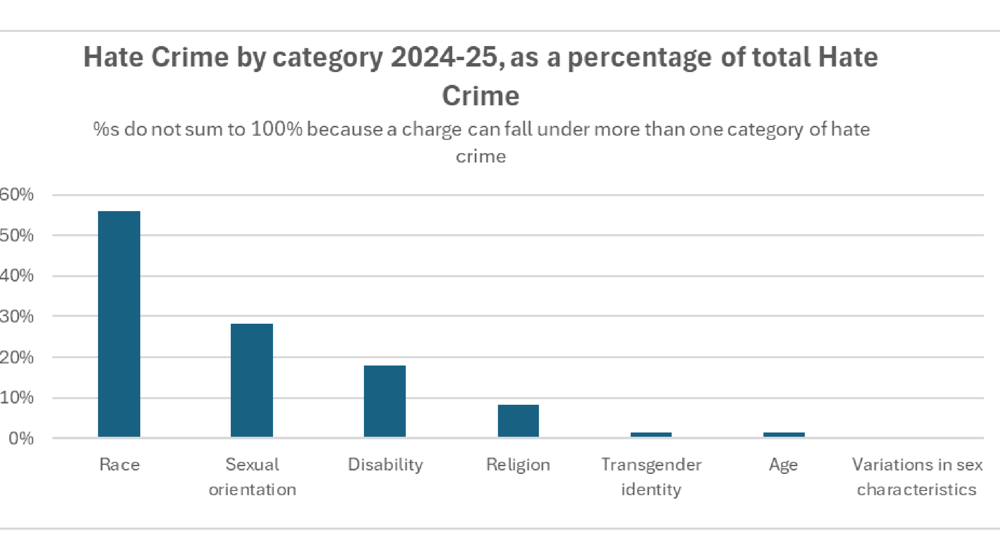
Introduction
This publication provides details of hate crime reported to the Procurator Fiscal in Scotland in 2024-25. The majority of the figures for 2024-25 relate to charges reported under the Hate Crime and Public Order (Scotland) Act 2021 which came into effect on 1 April 2024. Further details of the new legislation are given in the Annex.
The publication also contains figures for charges reported under legislation relating to hate crime which was in force up to 31 March 2024. These offences were committed before 1 April 2024.
The relevant legislative provisions are provided in the Annex.
As well as figures on each of the seven separate categories of hate crime, figures on the total number of charges reported containing at least one element of hate crime are included in this publication. Additional information on the sex and age of accused persons, and on the substantive charges to which hate crime aggravations applied, is also provided.
Background
The information in this publication is obtained from the Crown Office and Procurator Fiscal Service (COPFS) operational database. The database manages and processes reports submitted to Procurators Fiscal by the police and other reporting agencies throughout Scotland. Since this is a live database, the figures in this publication may differ slightly from those published in earlier years due to changes made during the investigation and prosecution of a case.
The information in this publication covers 2015-16 to 2024-25. There is also some information on longer term trends. The earliest year for which consistent figures are available for racial and religious crimes is 2003-04. Figures are available for disability, sexual orientation and transgender identity hate crime following legislation that came into force on 24 March 2010. Figures for hate crime related to age and to variations in sex characteristics (VSC) are only available for 2024-25, following the introduction of the Hate Crime and Public Order (Scotland) Act 2021 which created these additional categories of hate crime.
The figures quoted in this publication relate to the number of charges reported rather than the number of individuals charged or the number of incidents that gave rise to such charges. Where a charge has more than one hate crime aggravation, it is included in the figures for each type of hate crime into which it falls.
Detailed tables containing the figures referred to in this publication are available separately as an Excel spreadsheet - Hate Crime in Scotland data tables. There are also tables providing a geographical breakdown, by the Procurator Fiscal Office to which the charges were reported.
The tables include information on the initial decision taken by Procurators Fiscal on how a charge will proceed. This includes the decision to take court proceedings or to use alternatives to prosecution including fiscal fines and other Direct Measures.
Figures for charges not separately prosecuted include charges which were not prosecuted directly but where details may have been incorporated into charges that were prosecuted. For example, two charges reported by the police may have been merged into one comprehensive charge and then prosecuted. The decision on how these charges proceeded will be counted as court proceedings for one charge and as not separately prosecuted for the other.
A detailed definition on what is included in each decision category is provided in the Annex. A breakdown of the reasons for taking no action is provided in Table 13.
Race crime (Tables 1a, b, c and d, Table 15)
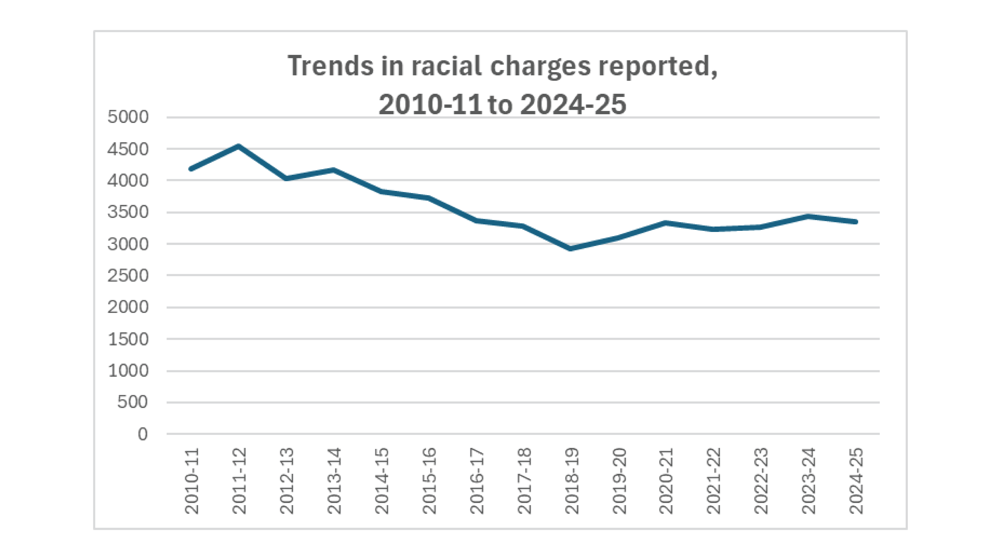
Court proceedings were commenced in respect of 80% of charges in 2024-25. In total, 90% of charges reported in 2024-25 led to court proceedings, including those not separately prosecuted but which may have been incorporated into other charges for the same accused which were prosecuted.
No action was taken in respect of 2% of charges. The remaining charges received either a Direct Measure, a referral to the Children’s Reporter, or are awaiting a final marking decision.
Racially aggravated offending can be prosecuted by using either a substantive racial charge or a racial aggravation, which can be added to any charge. Prosecutors will choose whichever option best fits the facts and circumstances of the offending behaviour. Up to 2014-15, most race crime was prosecuted using racial charges. However since then the trend has been to make more use of the racial aggravation. In 2024-25, the racial aggravation was used in 69% of racial harassment cases while a racial charge was used in 31% of such cases. Further details about racial charges and aggravations are in the Annex.
In 2024-25, 914 charges of racially aggravated harassment and/or behaviour were reported under section 3(1) of the Hate Crime and Public Order (Scotland) Act 2021. In addition, 107 charges were reported under Section 50A of the Criminal Law (Consolidation) (Scotland) Act 1995, covering analogous offences committed prior to 1 April 2024.
Twenty-seven charges were reported under section 4(1) of the Hate Crime and Public Order (Scotland) Act 2021, stirring up hatred against a group based on race, colour, nationality or ethnic origin.
Whilst any substantive charge can be aggravated by racial hatred, in 2024-25, 66% of offences reported with a racial aggravation related to charges of threatening or abusive behaviour under section 38 of the Criminal Justice and Licensing (Scotland) Act 2010. This is the most commonly used charge across most categories of hate aggravated offending.
Religious crime (Tables 2a, b, c and d, Table 16)
There were 505 charges with a religious aggravation reported in 2024-25, which is 5.1% fewer than in 2023-24. This is the lowest annual number of charges reported since 2004-05, and 44% lower than the peak in such charges in 2011-12 (896).
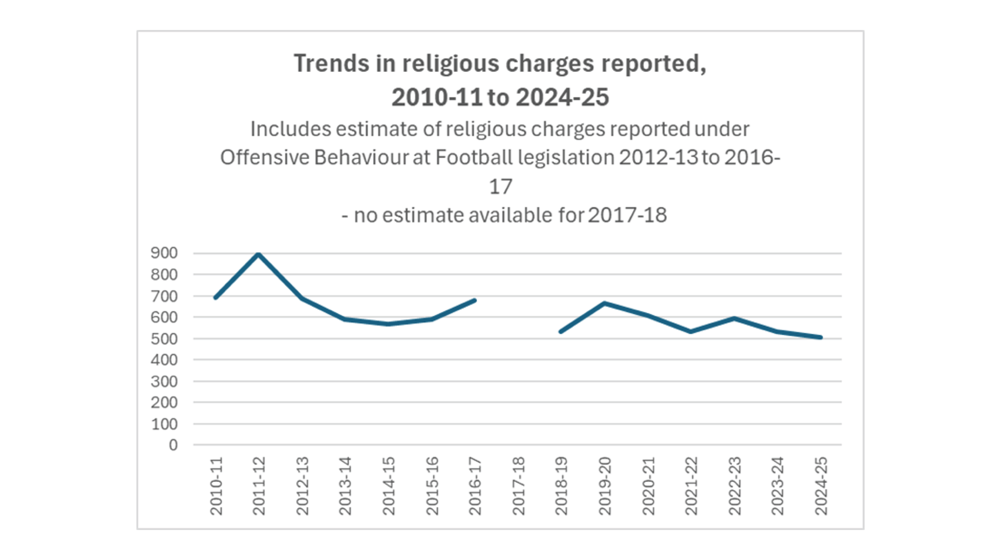
In the period 2012-13 to 2017-18 some charges that would otherwise have been reported with a religious aggravation will have been reported under the Offensive Behaviour at Football and Threatening Communications (Scotland) Act 2012. Research by the Scottish Government provided an estimate of how many additional religious charges there were under this Act in each year between 2012-13 and 2016-17. No estimate is available for 2017-18 due to repeal of the Act.
Comparisons of the number of charges reported with a religious aggravation between 2012-13 and 2017-18 inclusive, and other years are therefore estimates.
In 2024-25, court proceedings were commenced in respect of 81% of charges with a religious aggravation. In total, 93% of charges reported in 2024-25 led to court proceedings, including those not separately prosecuted but which may have been incorporated into other charges for the same accused.
No action was taken in respect of 1% of charges. The remaining charges received either a Direct Measure, a referral to the Children’s Reporter, or are awaiting a final marking decision.
In 2024-25, 77% of offences reported with a religious aggravation related to charges of threatening or abusive behaviour under section 38 of the Criminal Justice and Licensing (Scotland) Act 2010.
Disability (Table 3a, b and c, Table 17)
In 2024-25, 1,069 charges were reported with an aggravation of prejudice relating to disability, 15% more than in 2023-24. This is the highest annual number of charges reported since the initial legislation creating this aggravation came into force in 2010 and continues an almost unbroken upward trend in the numbers since.
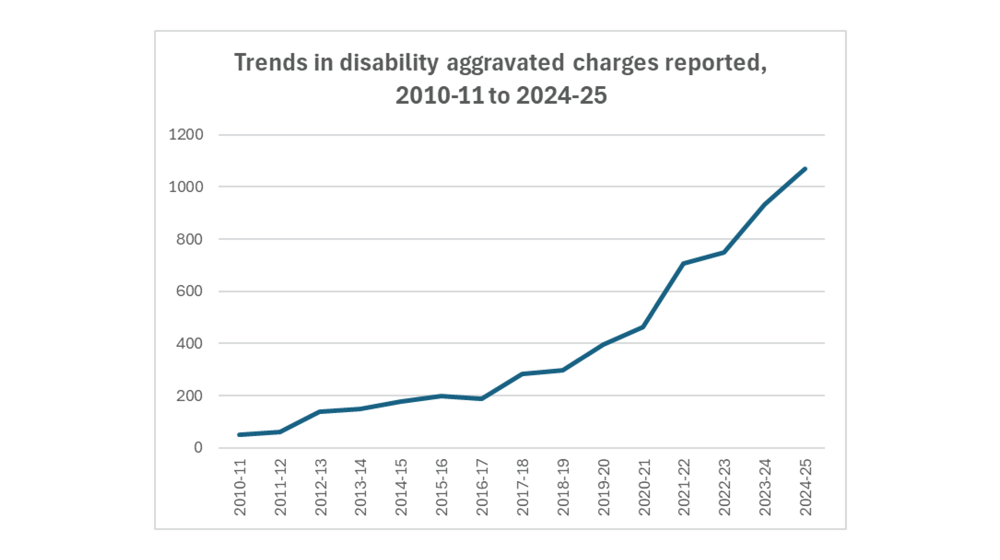
Court proceedings were commenced in respect of 83% of charges reported in 2024-25. In total 91% of charges led to court proceedings, including those not separately prosecuted, but which may have been incorporated into other charges for the same accused.
No action was taken in respect of 2% of charges reported in 2024-25. The remaining charges received either a Direct Measure, a referral to the Children’s Reporter, or are awaiting a final marking decision.
In 2024-25, 80% of offences reported with a disability aggravation related to charges of threatening or abusive behaviour under section 38 of the Criminal Justice and Licensing (Scotland) Act 2010.
Sexual orientation (Table 4a, b and c, Table 18)
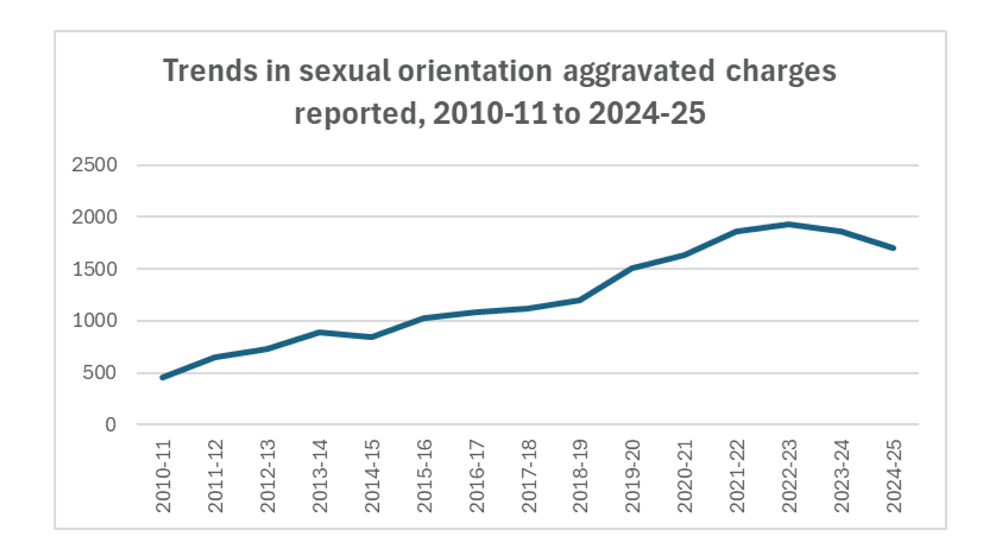
Court proceedings were commenced in respect of 80% of charges reported in 2024-25. In total 89% of charges led to court proceedings, including those not separately prosecuted, but which may have been incorporated into other charges for the same accused.
No action was taken in respect of 2% of charges. The remaining charges received either a Direct Measure, a referral to the Children’s Reporter, or are awaiting a final marking decision.
In 2024-25, 84% of offences reported with a sexual orientation aggravation related to charges of threatening or abusive behaviour under section 38 of the Criminal Justice and Licensing (Scotland) Act 2010.
Transgender identity (Table 5a, b and c, Table 19)
In 2024-25, 86 charges were reported with an aggravation of prejudice relating to transgender identity, 1 fewer (1.1%) than in 2023-24.

Court proceedings were commenced in respect of 74% (64 out of 86) of charges reported in 2024-25. In total 79% (68 out of 86) of charges led to court proceedings, including those not separately prosecuted, but which may have been incorporated into other charges for the same accused.
No action was taken in respect of 3% (3 out of 86) of charges reported in 2024-25. The remaining charges received either a Direct Measure, a referral to the Children’s Reporter, or are awaiting a final marking decision.
In 2024-25, 64% (55 out of 86) of offences reported with a transgender aggravation related to charges of threatening or abusive behaviour under section 38 of the Criminal Justice and Licensing (Scotland) Act 2010.
A further 16 offences (19%) related to charges involving non-sexual assault or assault to injury.
Age (Table 6a, b and c, Table 20)
In 2024-25, 88 charges were reported with an aggravation of prejudice relating to age. This is a new category of hate crime, created in the Hate Crime and Public Order (Scotland) Act 2021.
Court proceedings were commenced in respect of 59% (52 out of 88) of charges reported in 2024-25. In total 74% (65 out of 88) of charges led to court proceedings, including those not separately prosecuted, but which may have been incorporated into other charges for the same accused.
No action was taken in respect of 5% (4 out of 88) of charges reported in 2024-25. The remaining charges received either a Direct Measure, a referral to the Children’s Reporter, or are awaiting a final marking decision.
In 2024-25, 35% (31 out of 88) of offences reported with an age aggravation related to charges of threatening or abusive behaviour under section 38 of the Criminal Justice and Licensing (Scotland) Act 2010. This is the only category of hate crime where this charge accounts for under 50% of charges reported.
A further 23 offences (26%) related to charges of assault or assault to injury.
Variations in sex characteristics (VSC) (Table 7a, b and c, Table 21)
In 2024-25, 13 charges were reported with an aggravation of prejudice relating to VSC. This is a new standalone hate crime aggravation, created in the Hate Crime and Public Order (Scotland) Act 2021. Previously this characteristic was included within the definition of transgender identity.
Court proceedings were commenced in respect of 69% (9 out of 13) of charges reported in 2024-25. All 13 charges led to court proceedings, including those not separately prosecuted, but which may have been incorporated into other charges for the same accused.
In 2024-25, 77% (10 out of 13) of offences reported with a VSC aggravation related to charges of threatening or abusive behaviour under section 38 of the Criminal Justice and Licensing (Scotland) Act 2010.
Statutory hate crime charges (Table 8a)
The Hate Crime and Public Order (Scotland) Act 2021 is a consolidation of all previously existing hate crime legislation including charges previously reported under the Criminal Law (Consolidation) (Scotland) Act 1995 and the Public Order Act 1986. The 2021 Act also introduced a new “stirring up hatred” charge covering all the other, non-racial, categories of hate crime, namely age, disability, religious prejudice, sexual orientation, transgender identity and VSC.
There were 1,021 charges under both the old and new legislation reported in 2024-25, which can broadly be categorised as racially aggravated harassment and/or behaviour. This compares with 932 reported in 2023-24. Charges reported under the old legislation in 2024-25 will relate to offences prior to 1 April 2024. These charges are included in the figures for racial hate crime.
There were 27 charges under both the old and new legislation reported in 2024-25, which can broadly be categorised as stirring up of racial hatred. This compares with 3 reported in 2023-24. These charges are included in the figures for racial hate crime.
There were 65 charges under the new legislation reported in 2024-25, which can broadly be categorised as stirring up hatred on the basis of age, disability, religion, sexual orientation, transgender identity or VSC. These charges are included in the figures for total hate crime but are not included in the figures for individual categories of hate crime, because it is not possible to identify which protected characteristic was targeted without manual checking of case papers.
Total hate crime (Tables 9a and b)
If a charge has more than one hate crime aggravation, it is included in this publication in each type of hate crime into which it falls. It is therefore not possible to add up the charges for each category of hate crime to obtain the total number of hate crime charges reported. Table 9a provides this information, with charges which relate to more than one category of hate crime counted only once.
In 2024-25, 6,019 charges with at least one hate crime element were reported. This is 1.2% fewer than the total of 6,094 in 2023-24. However, figures for the two years are not directly comparable because the 2024-25 figure includes new categories of hate crime and new charges relating to hate crime introduced by the Hate Crime and Public Order (Scotland) Act 2021.
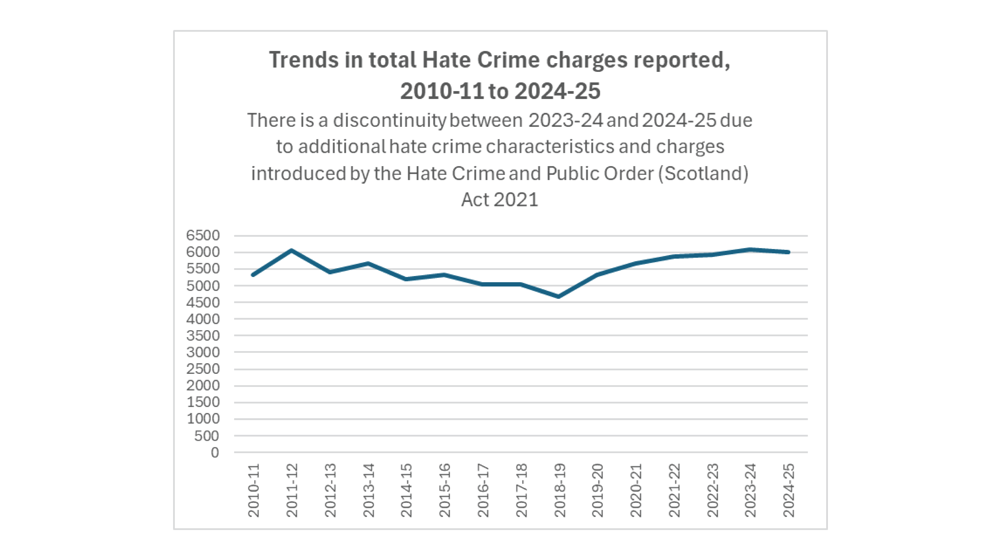
Whilst the total number of hate related offences has remained consistent over recent years, the nature of such offending has changed. Race related offending continues to represent more than half of all reported hate crime. In contrast, religious offending has dropped from the second most commonly reported hate crime to the fourth while offences related to sexual orientation and disability have risen to second and third most commonly reported respectively.
The proportion of charges containing a racial element has remained consistent at around 55% or 56% since 2021-22, following a gradual decrease in the preceding years from 70% in 2015-16. The proportion of hate crime charges that relate to sexual orientation was 28% in 2024-25. This proportion increased from 19% in 2015-16 to 33% in 2022-23 but has decreased slightly in the last two years. The proportion of charges that relate to disability increased from 4% to 18% between 2015-16 and 2024-25. In 2024-25 the proportion of religiously aggravated charges was 8%. None of the other hate crime categories accounts for more than 1% of charges.
Sex and age of accused (Tables 11a, Table 12a)
In 2024-25, of the 6,019 accused persons in charges which contained at least one hate crime element, 4,823 or 80% were male. This proportion rose to 85% for sexual orientation offences and 91% for religiously aggravated charges. All the accused in the 13 charges relating to VSC were male.
In 2024-25, 6% of accused persons in charges which contained at least one hate crime element were aged under 18, with a further 6% aged 18 to 20. Twenty-two per cent of accused persons were aged 21 to 30, 35% were aged 31 to 40, 19% were aged 41 to 50, 11% were aged 51 to 60, and the remaining 5% were aged over 60. Accused were relatively more likely to be aged 20 or younger for transgender identity (21%) and relatively more likely to be aged over 40 for religious charges (46%). They were relatively less likely to be aged over 40 for disability charges (25%). For age hostility charges, accused persons were relatively more likely to be either in a younger or older age group – either aged 20 or under (19%) or over 40 (52%).
The information on sex is as recorded by the police. Further details of the basis of the recording are included in the Annex. The figures by age and sex exclude any charges where this information was not recorded.
Annex
Legislation - up to 31 March 2024
Race crime is defined as any charge of racially aggravated harassment and/or behaviour in terms of Section 50A of the Criminal Law (Consolidation) (Scotland) Act 1995 or Section 18, 19, 21 or 23(1)a of the Public Order Act 1986 or any substantive charge that is racially aggravated in terms of Section 96 of the Crime and Disorder Act 1998.
To prove a charge of racially aggravated harassment and/or behaviour, two separate sources of evidence establishing the racial element are required.
In terms of Section 96 of the Crime and Disorder Act 1998, evidence from a single source is sufficient to prove a racial aggravation. The aggravation must be attached to a substantive charge, which must be corroborated by independent evidence from two separate sources.
Religiously aggravated offences is defined as a substantive charge that is aggravated by hostility towards a person’s perceived or actual faith or belief in terms of Section 74 of the Criminal Justice (Scotland) Act 2003.
Disability aggravated offences is defined as a substantive charge that is aggravated by hostility towards a person’ perceived or actual disability in terms of Section 1 of the Offences (Aggravation by Prejudice) (Scotland) Act 2009.
Sexual orientation aggravated offences is defined as a substantive charge that is aggravated by hostility towards a person’s perceived or actual sexual orientation in terms of Section 2 of the Offences (Aggravation by Prejudice) (Scotland) Act 2009.
Transgender identity aggravated offences is defined as a substantive charge that is aggravated by hostility towards a person’s perceived or actual transgender identity in terms of Section 2 of the Offences (Aggravation by Prejudice) (Scotland) Act 2009.
Legislation – from 1 April 2024
The Hate Crime and Public Order (Scotland) Act 2021 came into effect on 1 April 2024, and applies to offences committed from that date onwards. Any offences committed before that date will continue to be reported and prosecuted under the old legislation.
The Act seeks to modernise, consolidate and extend hate crime legislation in Scotland. The Act covers the five protected characteristics previously covered by hate crime legislation and adds two new groups: Age and Variations in sex characteristics (VSC). VSC was previously included until the category of transgender identity.
All aggravations operate in the same way as those previously in existence, namely only one independent source of evidence is required to prove the aggravation. The aggravation must be attached to a substantive charge, which requires two sources of independent evidence to prove.
The 2021 Act also creates a new suite of offences relating to stirring up of hatred that apply in relation to all seven characteristics covered by the Act. Previous stirring up legislation only applied to the characteristic of race. Just like any other substantive charge, a stirring up offence requires two sources of independent evidence, including to prove the specific characteristic of the hate crime.
In addition, the Act includes offences of racially aggravated harassment, superseding similar offences under earlier legislation. To prove a charge of racially aggravated harassment, two separate sources of evidence establishing the racial element are required.
The Act also abolishes the common law offence of blasphemy.
The seven hate crime characteristics are now
- Age
- Disability
- Race, colour, nationality (including citizenship), or ethnic or national origins
- Religion or, in the case of a social or cultural group, perceived religious affiliation
- Sexual orientation
- Transgender identity
- Variations in sex characteristics
Definitions
Not separately prosecuted include charges which were not prosecuted, but where other charges for the same accused within the same case were prosecuted. In some cases, the charges which were prosecuted may have included details from the charges which were not prosecuted. For example, two charges reported by the police may have been merged into one comprehensive charge and then prosecuted.
Direct measures include fiscal fines, fiscal compensation orders, fiscal work orders, warning letters and referral to diversion from prosecution schemes. The direct measures figures include a small number of charges which were not actioned, but where the accused was given a direct measure in respect of other charges within the same case. In some cases, the charges which were given a direct measure may have included details from the charges which were not actioned.
No action includes charges where a decision was taken not to proceed. This will include charges where there is insufficient evidence to proceed or where further action would be disproportionate. Table 13 gives a breakdown of the reasons for no action in 2024-25.
Cases awaiting decision include those where no decision has yet been taken, including those which have been reviewed and have been marked for “further enquiries” i.e. where more information is required before a final decision can be taken on whether to proceed.
Use of terms Sex and Gender
“Sex” can be considered to refer to whether someone is male or female based on their physiology and genetic makeup. “Gender” represents a social construct or sense of self that takes a wider range of forms.
Sex, as referred to in this bulletin, is generally identified by a police officer based on their assessment of whether a person presents as male or female. In most cases this is based on the physiology of a person rather than self-identified gender. It is recorded for operational purposes, such as requirements for searching. It is also included in the information reported to COPFS. However, in most cases, information regarding the sex or gender of accused persons is not essential to prosecute crime. It would only be essential where it is material to the proof of the crime.
COPFS will respect and use the chosen name and pronouns of an accused person in all communications with them.
In this report we refer to “sex” rather than “gender” because this better reflects recording practices in relation to this information. In reality, it is likely that recording includes a mixture of physiological and personal identity. The sex of a small number of accused is not recorded, where the police have not provided this information to COPFS.
Convictions
The figures in this publication relate to initial decisions taken by the Procurator Fiscal. Many of the charges reported in the most recent year, 2024-25, will not yet have reached a conclusion, so information on the final number convicted is not yet available.
Figures on convictions are published by the Scottish Government in Criminal Proceedings in Scotland statistics . Please note that there are significant differences in the way the Criminal Proceedings statistics measure activity in comparison to the figures in this report. In particular, this publication is based on charges reported, while the Criminal Proceedings figures are based on persons prosecuted or convicted, by main charge only. One person can be reported with one or more charges against them. Additionally, this publication is based on the year the charge was reported to COPFS. The Criminal Proceedings figures are based on the year of disposal. These differences are described in more detail in Annex C of the Criminal Proceedings publication.
Conviction information on aggravations is available in Tables 12 and 13 of the latest Criminal Proceedings publication. The latest figures available relate to convictions in 2022-23. These therefore relate to convictions under pre-April 2024 legislation.
Please note that figures for race crime cover convictions with racial aggravations only and do not include conviction information for racial charges, which accounted for 31% of racial crime reported in 2022-23.
The date of publication for convictions for 2023-24 will be made known when finalised on the Forthcoming Publications page of the Scottish Government website https://www2.gov.scot/Topics/Statistics/ForthcomingPubs
The Offensive Behaviour at Football and Threatening Communications (Scotland) Act 2012
The Offensive Behaviour at Football and Threatening Communications (Scotland) Act 2012 came into force on 1 March 2012 and was repealed on 20 April 2018. Previous editions of this publication prior to the repeal provided figures on the number of charges reported under the Act. There are no charges recorded on the COPFS database reported under the Act after 2017-18. If a charge reported in an earlier year under the Act contained a hate crime aggravation it will still be included in the overall figures for each type of hate crime into which it falls.
At the time of the repeal, COPFS conducted a review of all ongoing charges under the Act. This resulted in a number of such charges being amended to an alternative charge.
In many cases, charges under the Act did not include an aggravation, because the charge itself covered the relevant behaviour. However, in certain subsections of the Act, the charge did not include the behaviour against specific individuals or groups covered by the hate crime categories and in these instances the charge may have been reported with an aggravation. Where a charge that would previously have been reported and prosecuted under the Act has been amended to an alternative charge, that alternative charge may now include a statutory aggravation.
The repeal of the Act means that there is a discontinuity in the time series of figures given in this publication between 2016-17 and 2017-18. Figures for all categories of hate crime may be higher in 2017-18 and subsequent years than they otherwise would have been due to charges that would have been reported between 2013-14 to 2016-17 under the Offensive Behaviour at Football and Threatening Communications (Scotland) Act 2012 being reported as an alternative charge with an aggravation.
Conviction information on the Offensive Behaviour at Football and Threatening Communications (Scotland) Act 2012 is available in Annex E of the Criminal Proceedings in Scotland 2018-19 publication. Criminal Proceedings in Scotland, 2018-19, Annex E
Related Scottish Government publications
The Scottish Government published a report in May 2025 Hate crimes recorded by the police in Scotland, 2023-24. This report presents updated information on the number of hate crimes recorded by the police in Scotland during 2023-24 (along with previously published time series analysis since 2014-15). It includes information on hate crimes recorded by the police by crime, by associated hate aggravation(s), and by local authority area. This report covers the period immediately prior to the commencement of the Hate Crime and Public Order (Scotland) Act 2021.
The Scottish Government published a report in January 2023 Police recorded hate crime - characteristics: updated study This provides an update on work by Scottish Government statisticians and Police Scotland to review the availability of information on hate crime recorded by the police in Scotland. It includes new details on the characteristics of hate crime, based on a random sample of cases recorded by the police in 2020-21. This is a follow up study to the previous report Characteristics of police recorded hate crime in Scotland published in 2021.
The Scottish Government previously published research based on COPFS data which provides details of the circumstances of charges with religious aggravations. This includes information on the religion targeted, the location where the offence was committed, and the age and gender of the accused. Research has been published relating to charges reported in each year from 2010-11 to 2017-18.
The Scottish Government also previously published research which provides details of the circumstances of charges reported in each year from 2012-13 to 2016-17 under the Offensive Behaviour at Football and Threatening Communications (Scotland) Act 2012. This includes information on the location where the offence was committed including the football stadium if appropriate, the nature of the offensive behaviour, the age and gender of the accused and their football team affiliation. Due to the repeal of the Act, no similar research was published relating to charges reported in 2017-18.
Data sources, data quality and revisions
The information in this publication is taken from the COPFS operational database used to manage the processing of reports submitted to Procurators Fiscal by the police and other reporting agencies throughout Scotland. Since this is a live database, the figures given here may not exactly match those previously published. For instance, if the Procurator Fiscal amends a charge, the database only holds details of the amended charge.
This publication contains new figures for 2024-25, and revised figures for the previous two years. These reflect the most up-to date information recorded on the COPFS operational database at the time the publication was prepared (May 2025). Changes to the information recorded for earlier years are minimal, and no revisions have been made to these years.
The data included in this publication has undergone a series of validation checks. Where internal inconsistencies in the data, or missing information, have been identified, data on individual charges has been checked manually and corrected if necessary. This includes cross checking with information contained in case related documents where appropriate. Where necessary, data has also been cross checked with external sources, in particular data held by the Scottish Courts and Tribunal Service (SCTS) on cases that have come to court.
Checks have also been carried out on a sample of charges to ensure that the aggravation recorded has been added appropriately, with any errors identified corrected as necessary. This checking has primarily focused on disability aggravated charges because historically this is the category of hate crime where most mistakes have been discovered.
The total number of charges relating to the hate crime categories of transgender identity, age and, in particular, variations in sex characteristics is small. The percentages derived from these figures should therefore be treated with caution, because they are based on small numbers.
Percentages may not add up to 100% due to rounding.
An official statistics publication for Scotland
These statistics are official statistics. Official statistics are statistics that are produced by crown bodies, those acting on behalf of crown bodies, or those specified in statutory orders, as defined in the Statistics and Registration Service Act 2007.
COPFS statistics are regulated by the Office for Statistics Regulation (OSR). OSR sets the standards of trustworthiness, quality and value in the Code of Practice for Statistics that all producers of official statistics should adhere to.
Correspondence and enquiries
For enquiries about this publication please contact:
Fiona Roberts
Management Information Unit
Crown Office and Procurator Fiscal Service
Email: _ManagementInformationUnit@copfs.gov.uk
Thank you for your feedback.